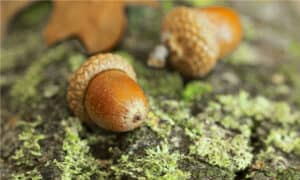The 10 Largest Citrus Fruits
Citrus fruits are produced by plants in the genus Citrus which are native to Australia, Asia, and Melanesia. The plants themselves vary from large shrubs to medium-sized trees which can be up to 49 feet high. Citrus fruits are best known for their distinctive fragrance and for the large quantity of juice that they produce. They contain large amounts of citric acid which in turn leads to them having a strong and often sharp flavor.
Citrus fruits are commercially important and are sold in large quantities around the world. They are eaten fresh, pressed for their juice, and used in many different recipes. Citrus fruit – just like the plants – vary greatly in size and the smallest has a diameter of only 1 inch. But just how big can they get? Join us as we discover the largest citrus fruits in the world!
#10 Largest Citrus Fruit: Iyokan Orange
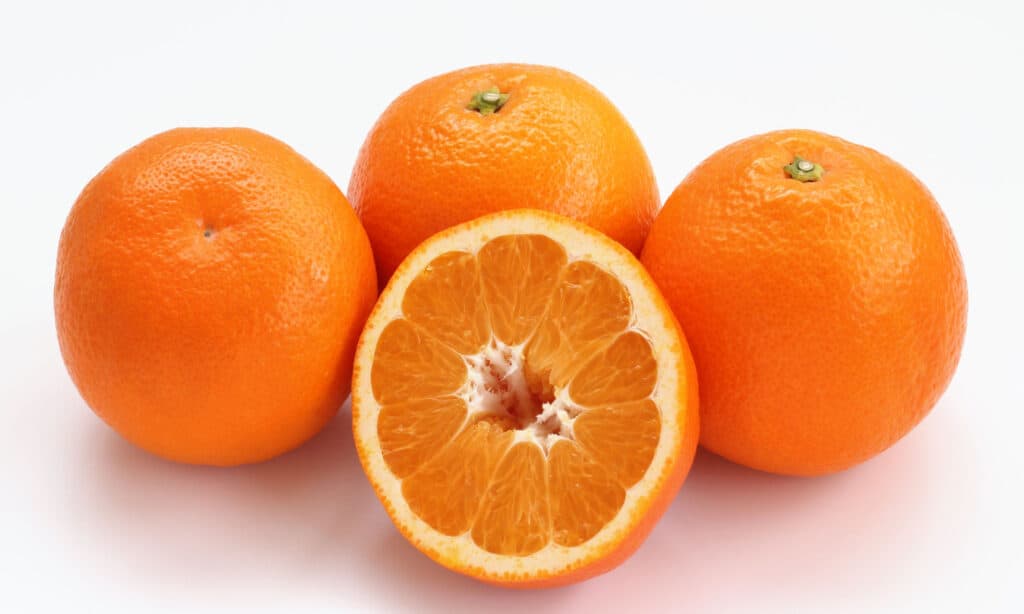
k–k/Shutterstock.com
The first citrus fruit on the list is the iyokan orange which has a diameter of 3.15 to 4 inches. Although a hybrid of unknown origin, iyokan oranges were originally discovered growing wild in a garden in Japan in the late 19th century. Iyokan oranges have a dark orange rind which is semi-thick and easy to peel. The white pith (also known as albedo) is bitter and usually discarded, but the oranges contain up to 10 segments that are tender and juicy. Iyokan oranges are best known for their sweet, citrus fragrance when peeled which makes them a popular choice for desserts and sauces. They are also highly sought after because of their desirable taste. Iyokan oranges have a high sugar content and are slightly acidic. However, their flavor is hailed as being the perfect balance of sweet and sour.
#9 Largest Citrus Fruit: Blood Orange
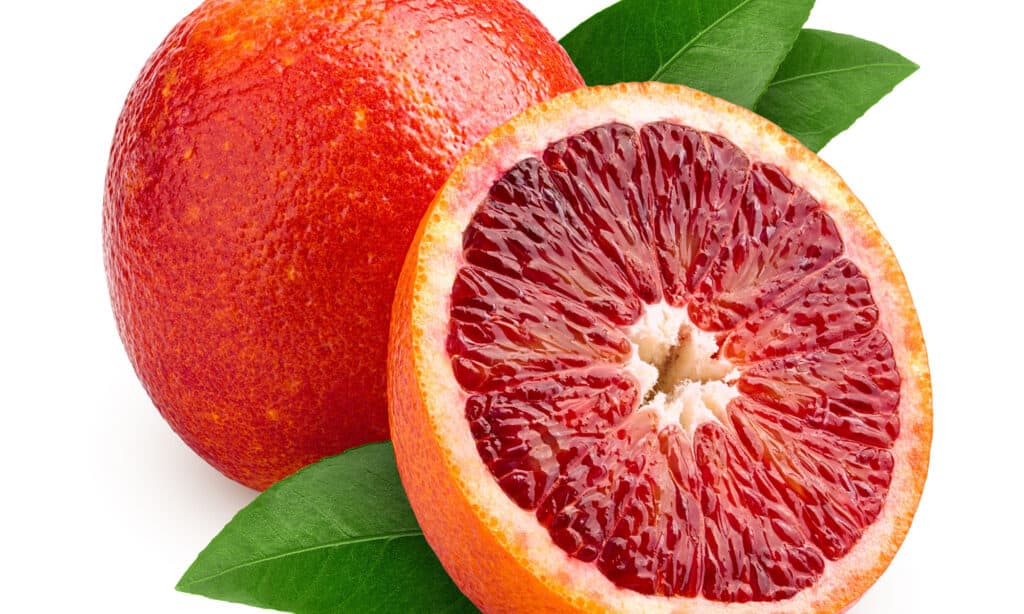
grey_and/Shutterstock.com
One of the most popular varieties of orange is blood orange. Blood oranges are around 4.5 inches wide and originated in the Mediterranean. At first glance, they have a very similar appearance to the typical orange with a bright orange rind. However, the inside is a much richer color and is a deep red, hence their name. Blood oranges get their distinctive colored flesh from anthocyanin which only develops when the fruit is ripened during warm days and cool nights. They also have a flavor that is as unique as their color and is described as being “raspberry-like”. With their sweet taste, blood oranges have many uses – including marmalade, salads, and baking.
#8 Largest Citrus Fruit: Oroblanco
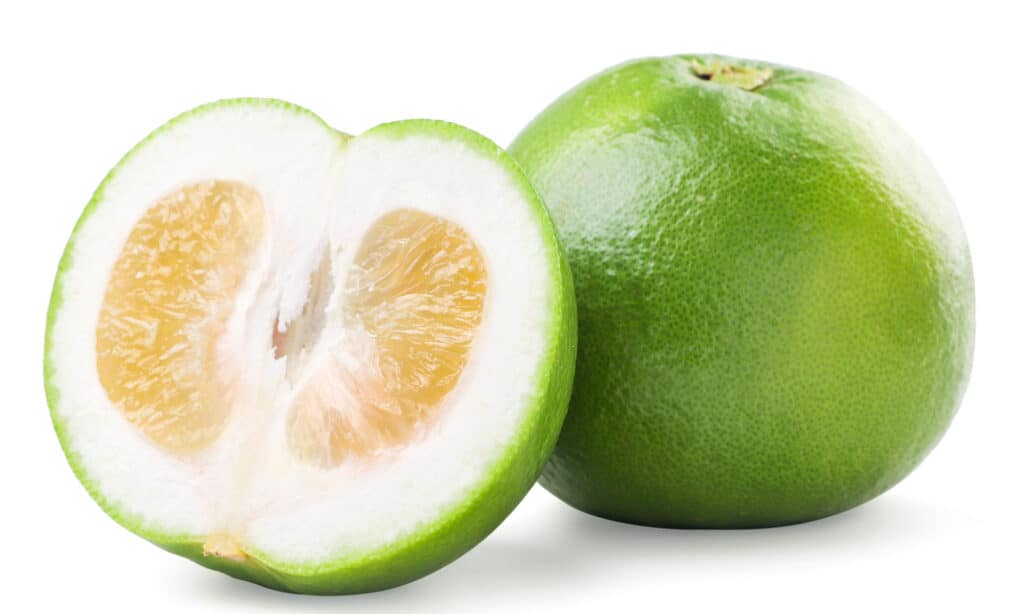
innakreativ/Shutterstock.com
Also referred to as the oroblanco grapefruit, oroblancos are a seedless citrus hybrid similar to grapefruit. Oroblancos have an average diameter of 4 to 4.7 inches and are round or oval. They are green to yellow when ripe and have a thick rind. Despite this, they are often peeled and eaten the same way as oranges as they easily separate into segments. The white pith and the membranes between the segments is bitter and not usually eaten. However, the segments themselves are not bitter or acidic and have a sweet taste. Oroblancos have many uses and are often used as breakfast and in many different desserts.
#7 Largest Citrus Fruit: Etrog
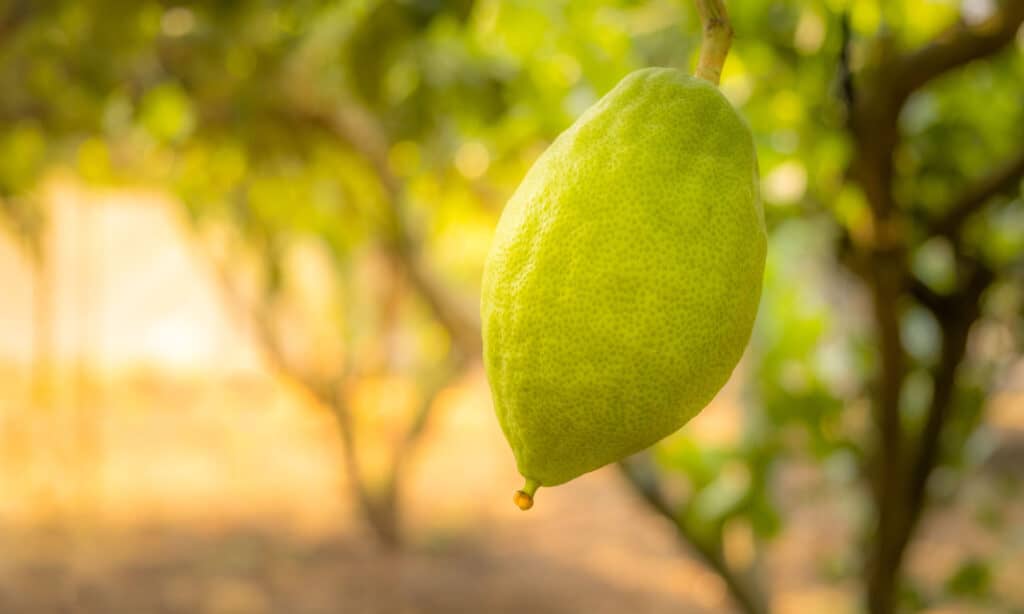
Seth Aronstam/Shutterstock.com
As a variety of citron, etrogs have a large size and are 4 to 6 inches long. At first glance, they can resemble a lemon or a lime, but they have much rougher skin that is thick and dry. They have pale yellow pulp and contain a lot of seeds. They also have an extremely bitter, acidic taste. Etrogs are often used in jams and preserves, with etrog marmalade being particularly popular. However, etrogs are also regularly used during the week-long Jewish holiday Sukkot. Sukkot is an agricultural festival that marks the end of harvest time. During this time, etrogs are used in religious rituals whereby they are often bound together with three other plants and prayers recited over them. Particular care is taken during the selecting of the etrog for the holiday.
#6 Largest Citrus Fruit: Orangelo

iStock.com/gresei
Orangelos are hybrid citrus fruits that are a cross between oranges and grapefruit. They originated in Puerto Rico and – although a hybrid – appeared completely spontaneously in Puerto Rican coffee plantations. Orangelos are slightly pear-shaped and have a diameter of 4 to 6 inches. They are usually yellow-orange on the outside but have brilliant reddish-orange insides. Orangelos are not bitter and have a much sweeter taste than grapefruit.
#5 Largest Citrus Fruit: Pompia
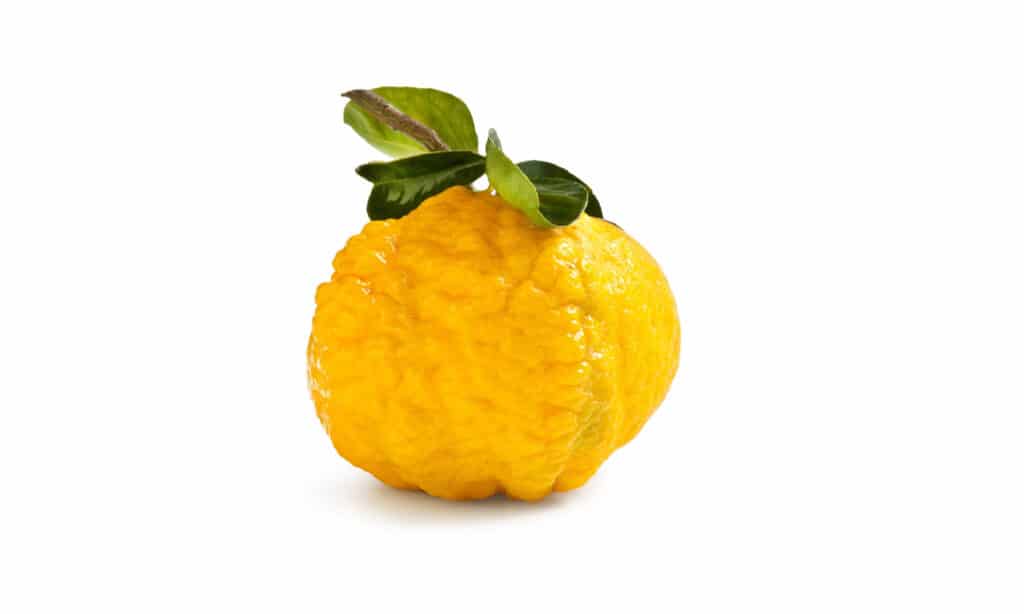
iStock.com/ItalianFoodProduction
One of the rarest citrus fruits in the world is the pompia, which is generally between 4 and 6 inches wide. Pompia (Citrus medica tuberosa) is a citrus hybrid – a cross between citron and sour oranges – which is endemic to Sardinia where it grows wild. Pompia are yellow when ripe and have a particularly rough rind. They have an unusual appearance and are either round of square and sometimes have a depression in the top and the bottom. Pompia have a thick white pith and particularly bitter pulp which is generally considered to be inedible. The flesh itself contains up to 14 wedges and is usually seedless.
#4 Largest Citrus Fruit: Grapefruit
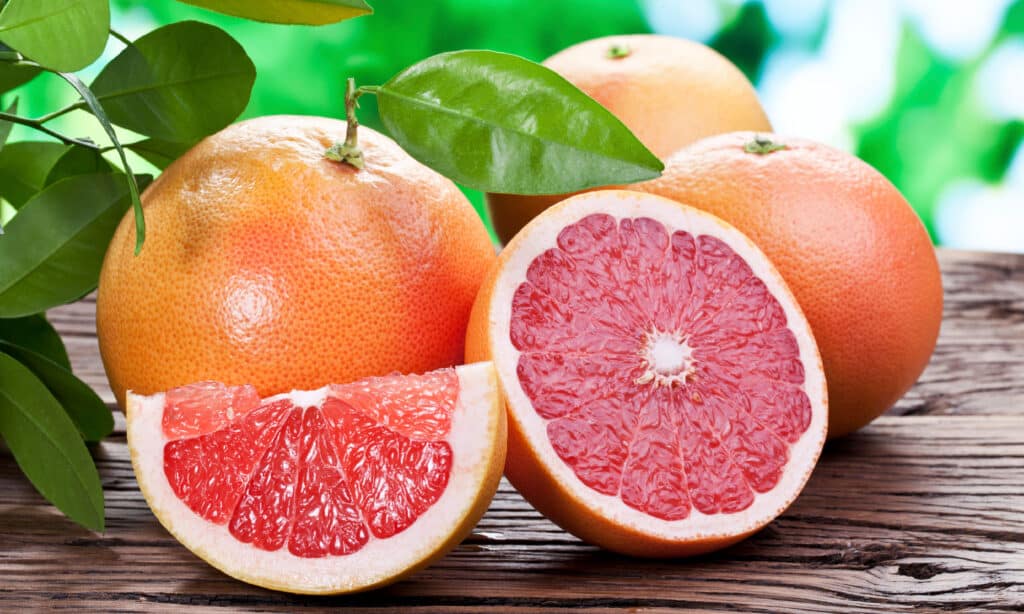
iStock.com/ValentynVolkov
One of the best-known citrus fruits is grapefruit. Grapefruit originated in Barbados and are actually a hybrid – a cross between sweet oranges and pomelos. They have a diameter of 4 to 6 inches and are a rich yellow-orange color. They have a thick rind and a bitter flavor. However, there are several different varieties which produce subtle changes in the sweetness and the flesh color. In general, the grapefruit with redder flesh have a sweeter taste. Eating grapefruit or drinking grapefruit juice often affects many types of medication. This causes adverse reactions unless the medication dose is adjusted accordingly. This is because grapefruit affects the way that drugs break down in our bodies, causing the medication level to become either too high or too low.
#3 Largest Citrus Fruit: Corsican Citron
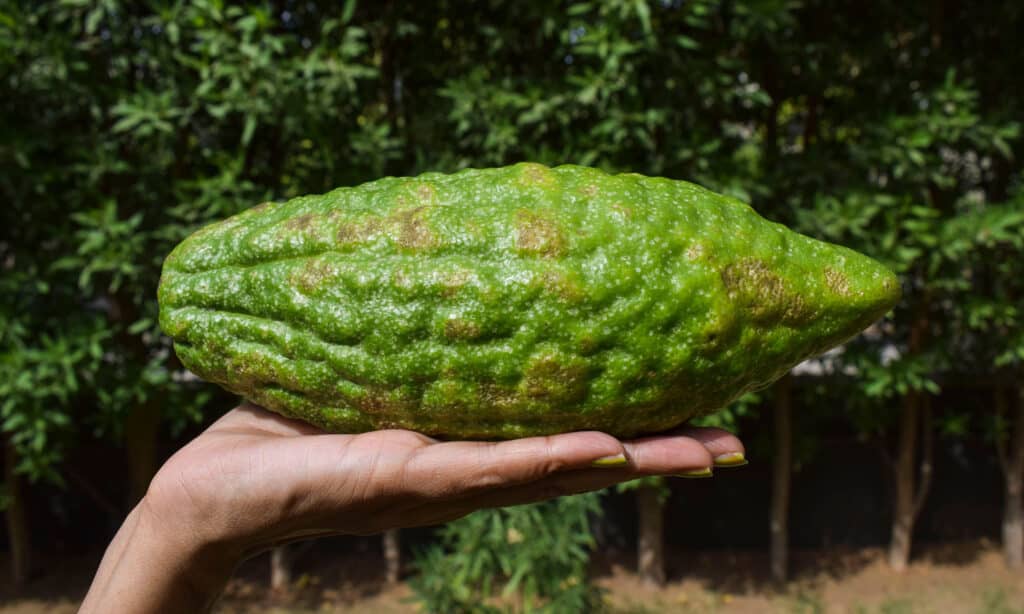
iStock.com/Rainbow_dazzle
One of the largest varieties of the citron fruit is the Corsican citron which can be up to 9.8 inches long. Corsican citrons originated in Corsica which is a Mediterranean island and is historically one of the most popular varieties of citron fruit. They have an elliptical shape and are bright yellow when they are ripe. They have a thick and fleshy rind which has a rough and bumpy surface. Corsican citrons produce very little juice but their flesh is crispy and sweet without being acidic.
#2 Largest Citron: Cedro Citron

iStock.com/giodilo
Another large citrus species is the cedro citron which reaches a diameter of 7.5 to 11.5 inches. Cedro citrons often look like overgrown and misshapen lemons with a wrinkled outer which turns bright yellow when ripe. They are the oldest of the four original citron species and originated in the Mediterranean thousands of years ago. However, they are now fairly rare and are mainly grown in Italy. Cedro citrons are unusual as up to 70% of the fruit is made up of the white pith (also known as albedo) which can be up to 2 inches thick. Compared to the white pith, cedro citrons contain very little fruit. Therefore, they are mainly used for their rind and white pith which is soft and spongy and can be eaten either raw or cooked.
#1 Largest Citrus Fruit: Pomelo
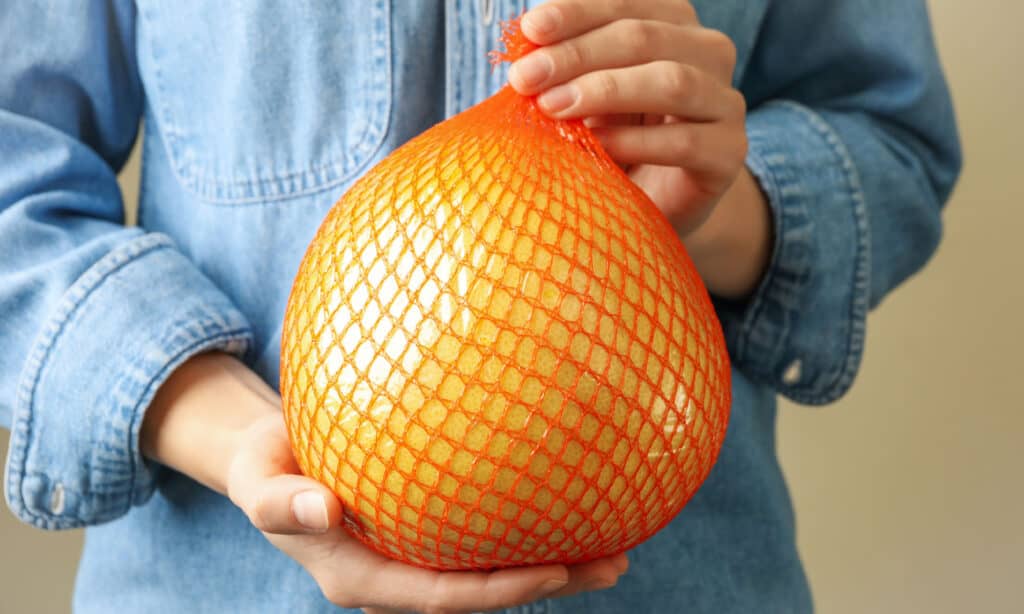
iStock.com/AtlasStudio
The largest citrus fruit in the world is the pomelo which has a diameter of 4 to 12 inches and can weigh between 2 and 4 pounds. Pomelos (Citrus maximus) are native to Southeast Asia and are the main ancestor of grapefruit. They have a tear drop shape and are greenish-yellow to pale yellow color. They also have thick skins which means that they keep for a long time. Pomelos are divided into 11 to 18 segments and usually contain only a few large seeds. Pomelos taste like a mild grapefruit and are regularly eaten as a dessert across Asia. They are also used in salads while their rind is used for making preserves.
More from A-Z Animals
Citrus fruits are produced by plants in the genus Citrus which are native to Australia, Asia, and Melanesia. The plants themselves vary from large shrubs to medium-sized trees which can be up to 49 feet high. Citrus fruits are best known for their distinctive fragrance and for the large quantity of juice that they produce. They contain large amounts of citric acid which in turn leads to them having a strong and often sharp flavor.
Citrus fruits are commercially important and are sold in large quantities around the world. They are eaten fresh, pressed for their juice, and used in many different recipes. Citrus fruit – just like the plants – vary greatly in size and the smallest has a diameter of only 1 inch. But just how big can they get? Join us as we discover the largest citrus fruits in the world!
#10 Largest Citrus Fruit: Iyokan Orange

k–k/Shutterstock.com
The first citrus fruit on the list is the iyokan orange which has a diameter of 3.15 to 4 inches. Although a hybrid of unknown origin, iyokan oranges were originally discovered growing wild in a garden in Japan in the late 19th century. Iyokan oranges have a dark orange rind which is semi-thick and easy to peel. The white pith (also known as albedo) is bitter and usually discarded, but the oranges contain up to 10 segments that are tender and juicy. Iyokan oranges are best known for their sweet, citrus fragrance when peeled which makes them a popular choice for desserts and sauces. They are also highly sought after because of their desirable taste. Iyokan oranges have a high sugar content and are slightly acidic. However, their flavor is hailed as being the perfect balance of sweet and sour.
#9 Largest Citrus Fruit: Blood Orange

grey_and/Shutterstock.com
One of the most popular varieties of orange is blood orange. Blood oranges are around 4.5 inches wide and originated in the Mediterranean. At first glance, they have a very similar appearance to the typical orange with a bright orange rind. However, the inside is a much richer color and is a deep red, hence their name. Blood oranges get their distinctive colored flesh from anthocyanin which only develops when the fruit is ripened during warm days and cool nights. They also have a flavor that is as unique as their color and is described as being “raspberry-like”. With their sweet taste, blood oranges have many uses – including marmalade, salads, and baking.
#8 Largest Citrus Fruit: Oroblanco

innakreativ/Shutterstock.com
Also referred to as the oroblanco grapefruit, oroblancos are a seedless citrus hybrid similar to grapefruit. Oroblancos have an average diameter of 4 to 4.7 inches and are round or oval. They are green to yellow when ripe and have a thick rind. Despite this, they are often peeled and eaten the same way as oranges as they easily separate into segments. The white pith and the membranes between the segments is bitter and not usually eaten. However, the segments themselves are not bitter or acidic and have a sweet taste. Oroblancos have many uses and are often used as breakfast and in many different desserts.
#7 Largest Citrus Fruit: Etrog

Seth Aronstam/Shutterstock.com
As a variety of citron, etrogs have a large size and are 4 to 6 inches long. At first glance, they can resemble a lemon or a lime, but they have much rougher skin that is thick and dry. They have pale yellow pulp and contain a lot of seeds. They also have an extremely bitter, acidic taste. Etrogs are often used in jams and preserves, with etrog marmalade being particularly popular. However, etrogs are also regularly used during the week-long Jewish holiday Sukkot. Sukkot is an agricultural festival that marks the end of harvest time. During this time, etrogs are used in religious rituals whereby they are often bound together with three other plants and prayers recited over them. Particular care is taken during the selecting of the etrog for the holiday.
#6 Largest Citrus Fruit: Orangelo

iStock.com/gresei
Orangelos are hybrid citrus fruits that are a cross between oranges and grapefruit. They originated in Puerto Rico and – although a hybrid – appeared completely spontaneously in Puerto Rican coffee plantations. Orangelos are slightly pear-shaped and have a diameter of 4 to 6 inches. They are usually yellow-orange on the outside but have brilliant reddish-orange insides. Orangelos are not bitter and have a much sweeter taste than grapefruit.
#5 Largest Citrus Fruit: Pompia

iStock.com/ItalianFoodProduction
One of the rarest citrus fruits in the world is the pompia, which is generally between 4 and 6 inches wide. Pompia (Citrus medica tuberosa) is a citrus hybrid – a cross between citron and sour oranges – which is endemic to Sardinia where it grows wild. Pompia are yellow when ripe and have a particularly rough rind. They have an unusual appearance and are either round of square and sometimes have a depression in the top and the bottom. Pompia have a thick white pith and particularly bitter pulp which is generally considered to be inedible. The flesh itself contains up to 14 wedges and is usually seedless.
#4 Largest Citrus Fruit: Grapefruit

iStock.com/ValentynVolkov
One of the best-known citrus fruits is grapefruit. Grapefruit originated in Barbados and are actually a hybrid – a cross between sweet oranges and pomelos. They have a diameter of 4 to 6 inches and are a rich yellow-orange color. They have a thick rind and a bitter flavor. However, there are several different varieties which produce subtle changes in the sweetness and the flesh color. In general, the grapefruit with redder flesh have a sweeter taste. Eating grapefruit or drinking grapefruit juice often affects many types of medication. This causes adverse reactions unless the medication dose is adjusted accordingly. This is because grapefruit affects the way that drugs break down in our bodies, causing the medication level to become either too high or too low.
#3 Largest Citrus Fruit: Corsican Citron

iStock.com/Rainbow_dazzle
One of the largest varieties of the citron fruit is the Corsican citron which can be up to 9.8 inches long. Corsican citrons originated in Corsica which is a Mediterranean island and is historically one of the most popular varieties of citron fruit. They have an elliptical shape and are bright yellow when they are ripe. They have a thick and fleshy rind which has a rough and bumpy surface. Corsican citrons produce very little juice but their flesh is crispy and sweet without being acidic.
#2 Largest Citron: Cedro Citron

iStock.com/giodilo
Another large citrus species is the cedro citron which reaches a diameter of 7.5 to 11.5 inches. Cedro citrons often look like overgrown and misshapen lemons with a wrinkled outer which turns bright yellow when ripe. They are the oldest of the four original citron species and originated in the Mediterranean thousands of years ago. However, they are now fairly rare and are mainly grown in Italy. Cedro citrons are unusual as up to 70% of the fruit is made up of the white pith (also known as albedo) which can be up to 2 inches thick. Compared to the white pith, cedro citrons contain very little fruit. Therefore, they are mainly used for their rind and white pith which is soft and spongy and can be eaten either raw or cooked.
#1 Largest Citrus Fruit: Pomelo

iStock.com/AtlasStudio
The largest citrus fruit in the world is the pomelo which has a diameter of 4 to 12 inches and can weigh between 2 and 4 pounds. Pomelos (Citrus maximus) are native to Southeast Asia and are the main ancestor of grapefruit. They have a tear drop shape and are greenish-yellow to pale yellow color. They also have thick skins which means that they keep for a long time. Pomelos are divided into 11 to 18 segments and usually contain only a few large seeds. Pomelos taste like a mild grapefruit and are regularly eaten as a dessert across Asia. They are also used in salads while their rind is used for making preserves.

